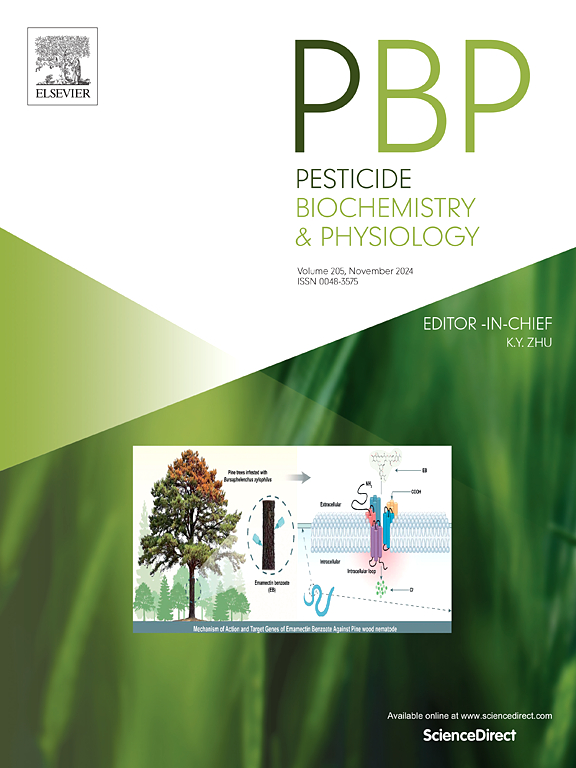Chemosensory protein 8 confers thiamethoxam resistance in Diaphorina citri
IF 4.2
1区 农林科学
Q2 BIOCHEMISTRY & MOLECULAR BIOLOGY
引用次数: 0
Abstract
The Asian citrus psyllid (Diaphorina citri) serves as the primary vector of the bacterium Candidatus Liberibacter asiaticus (CLas), which is responsible for causing citrus Huanglongbing. Neonicotinoid pesticides such as thiamethoxam are frequently utilized for D. citri management worldwide, but their use have resulted in considerable development of insecticide resistance within D. citri populations. Recent reports have revealed that chemosensory proteins (CSPs)-mediated resistance represents a novel insecticide resistance mechanism in insects. In this finding, we found that exposure to thiamethoxam at different concentrations resulted in significant upregulation of transcriptional levels of DcitCSP8 by 2.41, 2.24 and 1.74-fold respectively. The expression profiles among different tissues showed that DcitCSP8 highly occurred in the legs and wings, and its expression being significantly induced by thiamethoxam with 2.40-fold increase specifically in the legs. The purified recombinant protein DcitCSP8, derived from Escherichia coli expression, present strong in vitro binding affinity (Ki = 4.74 μM) to thiamethoxam. Furthermore, the nanocarrier star polycation (SPc) was used to enhance silencing efficiency, resulting in a significant reduction of DcitCSP8 by 85.37% and 91.80% at 24 and 48 h post application of SPc + ds DcitCSP8. Knockdown of DcitCSP8 transcription significantly increased the susceptibility of D. citri adults in response to thiamethoxam, while reinjection of DcitCSP8 protein could restore the resistance in DcitCSP8-silenced individuals. Our findings highlight the association between DcitCSP8 and thiamethoxam resistance via high binding affinity that mitigates toxicity in D. citri, shedding light on CSP-mediated insecticide resistance and potentially contributing to the development of novel strategies targeting CSPs for managing resistance in D. citri.

求助全文
约1分钟内获得全文
求助全文
来源期刊
CiteScore
7.00
自引率
8.50%
发文量
238
审稿时长
4.2 months
期刊介绍:
Pesticide Biochemistry and Physiology publishes original scientific articles pertaining to the mode of action of plant protection agents such as insecticides, fungicides, herbicides, and similar compounds, including nonlethal pest control agents, biosynthesis of pheromones, hormones, and plant resistance agents. Manuscripts may include a biochemical, physiological, or molecular study for an understanding of comparative toxicology or selective toxicity of both target and nontarget organisms. Particular interest will be given to studies on the molecular biology of pest control, toxicology, and pesticide resistance.
Research Areas Emphasized Include the Biochemistry and Physiology of:
• Comparative toxicity
• Mode of action
• Pathophysiology
• Plant growth regulators
• Resistance
• Other effects of pesticides on both parasites and hosts.

 求助内容:
求助内容: 应助结果提醒方式:
应助结果提醒方式:


